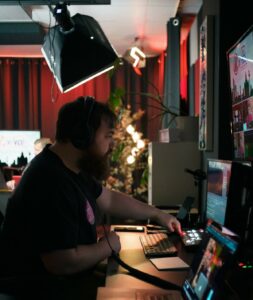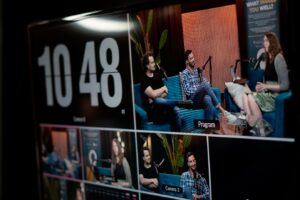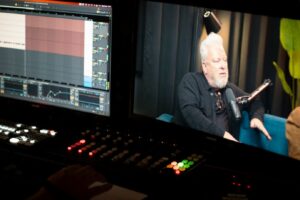
Do you have a compelling podcast idea that you’re eager to share with the world? Are you passionate about your topic and ready to connect with a like-minded audience? To ensure your vision translates effectively, you need the right equipment. Think of it this way: clear, high-quality audio is what allows your message to resonate and creates a lasting, positive impression on your listeners.
While a strong concept is the foundation of a great podcast, audio quality is essential for building trust and establishing yourself as an authority in your niche. It’s what elevates your podcast from an amateur endeavour to a professional production.
Unfortunately, the world of podcasting equipment can be overwhelming. Deciphering the myriad of microphones, interfaces, and software can easily become a roadblock. What equipment genuinely suits your needs and your budget? Where should you focus your investment?
That’s where we come in! Here at Liverpool Podcast Studios, we’ve helped podcasters of all sizes and all levels of experience to turn their vision into a reality and capture the audience their ideas deserve. So whether you’re looking to start a podcast for your B2B business or just want to get to work on a fun side project, let us help you cut through the noise and find the best podcast equipment for your needs.
The essential toolkit
Podcasting, at its core, is about capturing and sharing your voice. To do this effectively, you need a few fundamental tools. Think of these as the building blocks of your podcast – the non-negotiable elements that allow you to record, monitor, and refine your audio. This essential toolkit lays the groundwork for creating a polished podcast, providing the technical foundation upon which you can build your unique voice and content.
So, let’s begin by looking at the key pieces of equipment that any podcaster needs.

Microphones
Your microphone is arguably the most important piece of gear in your podcasting arsenal. It directly influences how your voice and guests will sound to your audience. Understanding the different types of microphones and their strengths is crucial for making an informed choice. The key decisions you’ll need to consider are:
- USB vs. XLR. USB microphones offer simplicity and are ideal for solo podcasters or if you’re just starting out with a DIY setup. XLR microphones give you more flexibility, but usually need an audio interface or mixer, making them better for setups with multiple mics. XLR mics also offer a wider range of upgrade options as your podcast grows.
- Dynamic vs. condenser. Dynamic microphones are robust, handling loud voices and noisy environments well. Condensers pick up more detail and nuance, making them excellent for studio-like settings or when recording softer-spoken voices.
- Budget. Don’t fall into the trap of thinking you need the most expensive microphone. There are fantastic options at every price point to help you sound your best. A cheap USB mic suitable for starting out can set you back as little as £30-50, while you can get your hands on a mid-range XLR for £100-200.
Finding the right microphone is about getting the right balance of your recording style, where you record, your budget, and even how you expect your podcast to evolve over time. There’s no single “best” microphone, but there’s one out there that’s perfect for your specific podcasting journey.
Headphones
Choosing the right headphones is essential for ensuring you’re capturing the best possible audio and delivering a polished listening experience. Headphones let you hear exactly what your microphone is picking up, allowing you to catch potential issues like background noise, distracting pops and clicks, or even simple volume adjustments during the recording process. Here’s what matters most:
- Closed-back. Choose over-ear headphones with a closed-back design to block out external sounds, preventing them from bleeding into your recording.
- Comfort. Since you’ll likely have them on for long periods, comfort is key for focus, preventing fatigue, and ensuring you can give your full attention to the recording.
- Accurate sound. You want headphones that reproduce sound faithfully, with a balanced, neutral sound presentation. Avoid headphones designed for casual music listening, as they often boost the bass and can mask problems in your recording.
Your headphones are your quality control during recording, and they can even affect your performance. Look for a comfortable, closed-back pair that provides a true sense of what your podcast will actually sound like when your listeners press play, allowing you to make any necessary adjustments on the fly.

Audio interface / mixer
An audio interface or mixer becomes essential when you expand beyond a simple solo podcasting setup, and you want to create a truly professional sound. They allow you to connect multiple microphones, route audio from online calls for remote guests, offer more precise control over your sound mix, and often unlock additional recording features. Here’s how to find the right one:
- Number of inputs. When choosing an interface, you’ll want one that can match or slightly exceed your microphone needs. By leaving some room to grow, you won’t have to upgrade your interface immediately if your podcast evolves.
- Ease of use. A complex interface can be intimidating and hinder your workflow. Look for models with sensible layouts and clear labelling, especially if you’re new to audio mixing.
- EQ. Some interfaces and mixers include built-in EQ controls. These allow you to adjust the tonal balance of your audio, boosting or cutting specific frequencies. This can be helpful for fine-tuning your microphone sound or compensating for slight room acoustics.
- Phantom power Most condenser microphones require phantom power to function. If you plan on using a condenser microphone, make sure the interface or mixer you choose has phantom power.
If you’re starting with a solo podcast and a USB microphone, you can most likely skip the mixer for now. However, an interface or mixer unlocks greater potential, creative control, and the ability to handle more complex recording scenarios as your podcast grows and your needs change.

Taking it to the next level
You’ve got the essential toolkit for recording your podcast – now it’s time to refine your sound and add those extra touches that set a professional podcast apart. These affordable upgrades will help you eliminate distractions and ensure your voice shines through with clarity.
Pop filters
Pop filters are a remarkably simple yet incredibly effective tool in any podcaster’s arsenal. Think of them as a shield between your microphone and those harsh “p” and “b” sounds (called plosives), which can distort your recording and be unpleasant for listeners.
When it comes to picking the best pop filter for your setup, you should consider:
- Type. You’ll need to choose between a mesh screen pop filter or a nylon fabric version. Both are effective, with mesh often being slightly more durable.
- Flexibility. A flexible gooseneck allows you to easily adjust the position of the pop filter for optimal placement in front of your mic.
- Mount. Consider how it attaches to your mic stand (some have clamps, others screw-on). Check for compatibility with your existing setup.
Pop filters come in a variety of styles and price points, but even the simplest pop filter makes a noticeable difference in audio quality, especially when you’re starting out. If budget is a concern, don’t hesitate to start with a basic option. Focus on choosing one that’s easy to use, has a flexible gooseneck for positioning, and mounts securely to your existing mic stand.
Mic arms / stands
While you can technically set your microphone on a desk, dedicated mic arms and stands offer significant benefits for both sound quality and recording comfort. When choosing one, make sure you think about:
- Desk mount vs. boom arm. Desk mounts are compact and clamp directly to your desk, while boom arms offer greater reach and flexibility for positioning. Assess your workspace needs and what kind of mic placement options you want.
- Weight capacity. Make sure the stand or arm can safely support the weight of your microphone, especially if it’s on the heavier side. Check the specifications to avoid issues with sagging or instability during recording.
- Build quality. A sturdy stand or arm will minimise unwanted movement and wobbles. Look for solid construction, smooth joints, and secure tightening mechanisms that keep everything in place once adjusted.
A good microphone arm or stand is an investment in both comfort and sound quality. When choosing, prioritise compatibility with your microphone, the flexibility that matches your recording style, and build quality that ensures a hassle-free setup.

The rest of the equation
Your microphone, headphones, and any upgrades are the core of capturing great audio. However, there are a few more elements that complete your podcasting toolkit, ensuring a smooth workflow from the moment you hit “record” right up to when you share your finished episode with the world. Let’s break down the remaining essential components.
Recording software
Recording software, often referred to as a DAW (Digital Audio Workstation), is where you’ll capture your voice, edit your episodes, and prepare them for sharing with the world. Here’s what to consider when choosing:
- Free vs. paid. Great options exist at both levels. Popular free choices include Audacity and GarageBand, while paid DAWs often offer more advanced editing tools and features.
- Ease of use. A user-friendly interface is crucial, especially when starting out. Look for software with a layout that makes sense and resources for learning the basics.
- Features. Consider the specific features you need for editing and production. Free software is excellent for basic tasks, while paid DAWs usually unlock more advanced tools (multitrack editing, noise reduction, automation, etc.).
Your recording software choice depends on your budget and experience level. Start with a free option if you’re unsure, and you can always upgrade later as your skills and needs evolve.
Podcast hosting services
You’ve poured your heart and soul into crafting a fantastic podcast episode – now you want the world to hear it! Podcast hosting is the crucial bridge that gets your polished episodes from your editing software to the ears of listeners on all the major podcast platforms like Spotify, YouTube and Apple Podcasts. It acts as your podcast’s home on the internet, storing your audio files, generating a unique RSS feed, and ensuring your show is discoverable by potential fans.
- Plans and features. Each hosting provider has various pricing plans based on storage space, analytics, and other features.
- Reliability. Research the host’s uptime and reputation, as this directly affects whether listeners can actually access your episodes.
- Customer support. Responsive and helpful customer support is invaluable, especially when you’re starting or if technical issues arise.
Podcast hosting is a necessary ongoing cost for most podcasts. Consider your budget and what features are important for your growth when choosing a host.

Access the best podcast equipment at Liverpool Podcast Studios
Armed with all this knowledge about the best podcast equipment, you’re well-placed to make informed choices and get the right tools for your needs and budget. However, there’s another approach to consider: leveraging the expertise and resources of a professional podcast studio.
Podcast studios offer a unique advantage over DIY setups: access to top-tier, professional-grade equipment without the upfront investment. Imagine utilising high-quality microphones, mixing consoles, and comfortable, aesthetically pleasing sets – all readily available for your podcasting sessions. This eliminates the need to purchase expensive equipment you might not use every day, and frees up your budget for other creative aspects of your podcast like guest interviews or marketing efforts.
But the benefits extend far beyond the gear. Here at Liverpool Podcast Studios, for instance, all of our customers work with a dedicated producer, who can provide technical expertise and ongoing support. This allows you to focus on delivering your best performance and creating compelling content, without getting bogged down in technical details.
And once the recording session is over, we offer a full suite of post-production services, from editing and uploading your podcast to providing transcripts, adding chapters, and choosing clips for social media.
To find out how we can help you deliver a podcast that will grab your listeners’ attention and keep them coming back for more, get in touch today.
